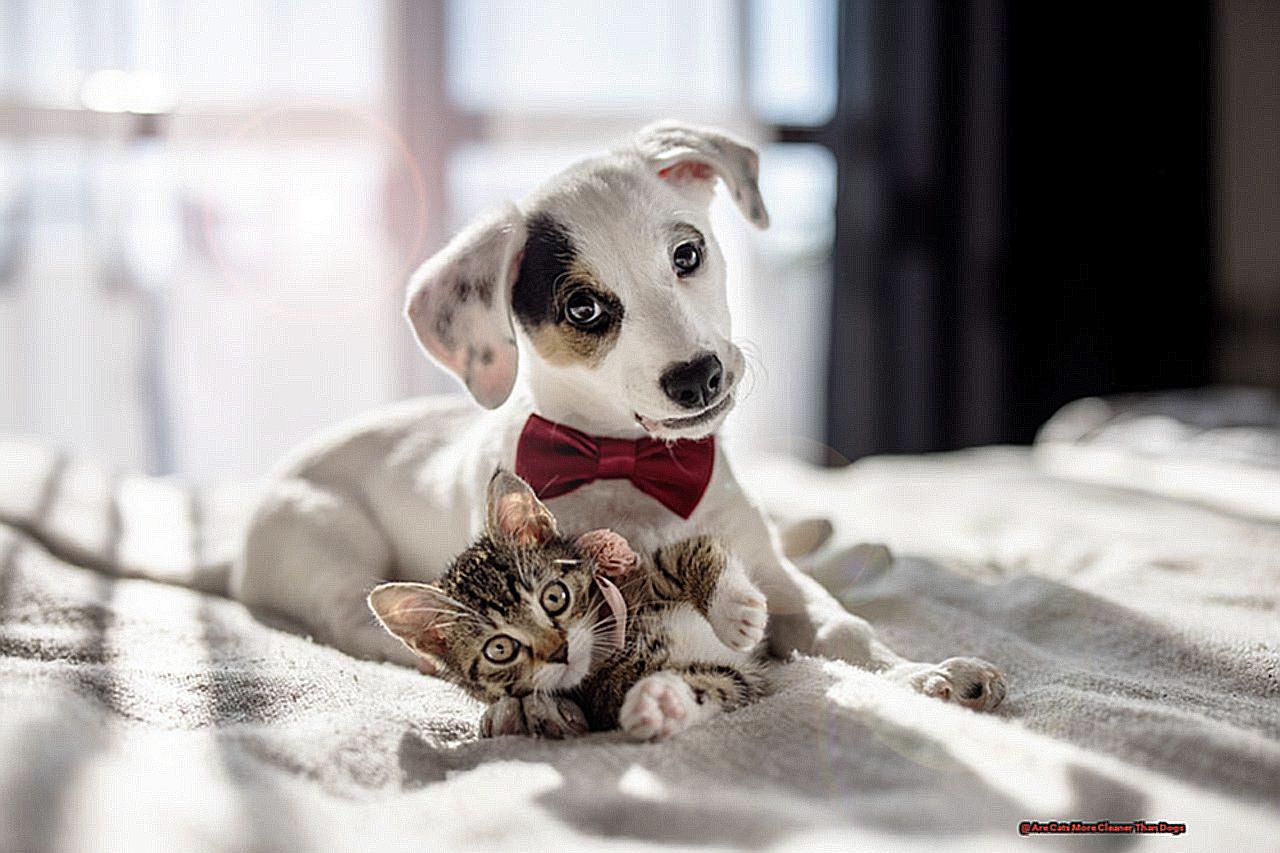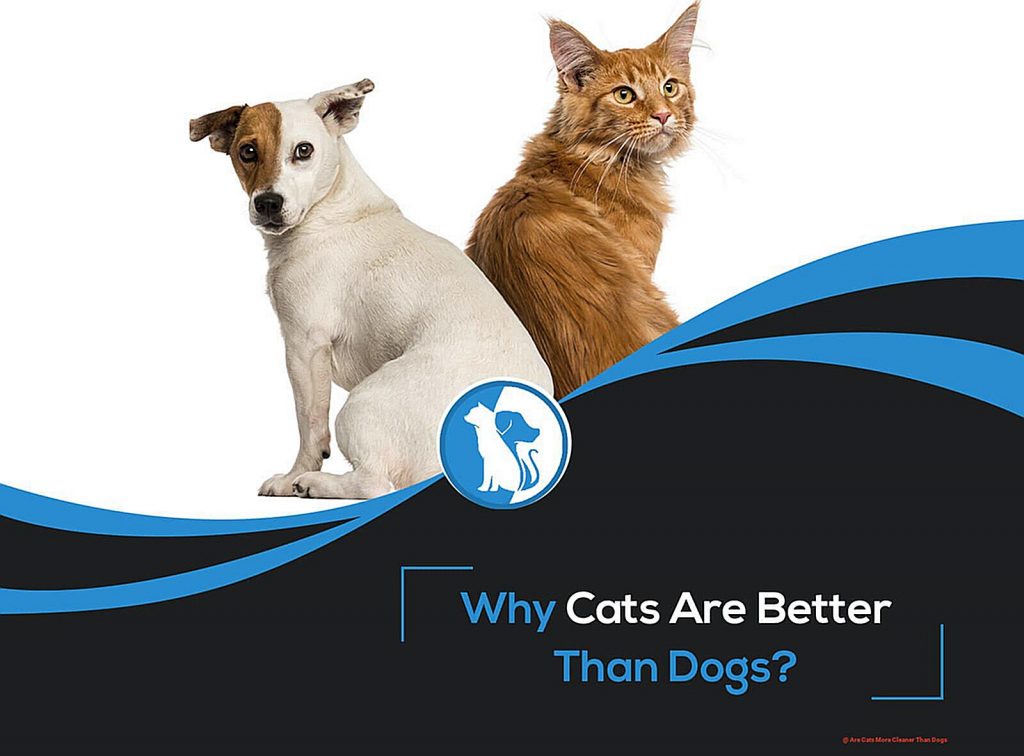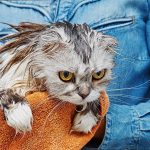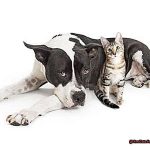Cats versus dogs: an age-old debate that never fails to stir up strong opinions among pet owners. While we may argue about which animal makes a better snuggle buddy or guard dog, there’s one aspect that often goes unnoticed – cleanliness. Let’s face it, our furry friends can leave quite a mess behind. But when it comes to taking care of their own hygiene, do cats or dogs come out on top?
In this blog post, we’ll take a closer look at the grooming habits of these beloved pets and determine once and for all which one reigns supreme in terms of tidiness.

So whether you’re Team Cat or Team Dog, get ready to discover who truly deserves the title of the cleaner companion.
Are Cats More Cleaner Than Dogs?
Contents
We all want our furry friends to be clean and healthy. However, when it comes to grooming habits, cats and dogs have different approaches. While cats are known for their fastidious grooming habits, dogs may require more assistance from their owners. So, what exactly sets these two animals apart when it comes to cleanliness?
Instinct vs. Assistance
One of the main differences in grooming habits between cats and dogs lies in their instincts. Cats have a natural instinct to keep themselves clean, which stems from their wild ancestors who needed to stay clean to avoid predators. This instinct is evident in their daily routine of grooming themselves using their rough tongues as a comb.
On the other hand, dogs do not have the same instinct for cleanliness as cats. They may require more assistance from their owners in terms of keeping clean. Their smooth tongues are not as effective at removing dirt and debris, and they have fewer hair follicles, making their fur less self-cleaning.
Maintenance is Key
While cats may groom themselves regularly, this does not mean they don’t require any maintenance from their owners. Regular brushing is still necessary to remove excess hair and prevent matting. On the other hand, dogs require more hands-on grooming, such as brushing and bathing, to maintain their cleanliness. The level of maintenance may vary depending on the breed and length of fur.
In terms of eliminating waste, cats are known for being particular about using a litter box, making it easier for owners to keep their living spaces clean. Dogs may need more training and supervision in this area or require regular trips outside to do their business.
Cleanliness Beyond the Fur
Apart from grooming habits, both cats and dogs can contribute to the overall cleanliness of a household in different ways. Cats are natural hunters and may catch insects or rodents, which can be beneficial in reducing pests in the house. On the other hand, dogs can also act as a deterrent with their presence and barking, keeping pests at bay.
It’s important to note that both cats and dogs can carry bacteria and parasites that can be harmful to human health. Cats are known carriers of Toxoplasma gondii, while dogs can carry Salmonella and E.coli. Proper hygiene practices, such as regular hand washing after handling pets and keeping living spaces clean, are essential in preventing the spread of these illnesses.
Shedding: A Common Issue for Both Cats and Dogs
You may have experienced the frustration of finding fur all over your furniture, clothes, and floors. Shedding is a common issue for both cats and dogs, but do you know why they do it and how to manage it? As an expert on the topic, I’m here to provide you with a comprehensive explanation of shedding in cats and dogs.
What Causes Shedding?
Both cats and dogs shed their fur as part of their natural grooming process. It allows them to get rid of old or damaged hair and make way for new growth. Shedding is also influenced by factors such as breed, age, and health. For example, long-haired breeds tend to shed more than short-haired breeds, and older animals may have thinner coats that shed less.
Cats vs. Dogs: Shedding Differences
While both cats and dogs shed, there are some differences in their shedding patterns. Cats typically shed more during the spring and fall months as they prepare for changes in weather and temperature. On the other hand, dogs shed all year round and may have a heavier shedding period twice a year.
Another significant difference is that cats have a natural instinct for self-grooming, while dogs require more assistance from their owners to maintain their hygiene. This is why regular grooming is essential for managing shedding in both cats and dogs.
Managing Shedding Through Grooming
Regular grooming is crucial for managing shedding in cats and dogs. Brushing their fur daily can help remove loose hair and prevent it from ending up on your furniture or clothes. It also helps distribute natural oils in their coat, promoting a healthy shine.
But don’t worry if your furry friend isn’t a fan of brushing. There are other ways to manage shedding such as using lint rollers or vacuuming regularly. You can also invest in furniture covers or designated pet beds to minimize fur on your upholstery.
Professional grooming services can also be an option for pet owners looking to manage shedding in their pets. These services involve a deep cleaning of their coat and can help remove any mats or tangles that contribute to excessive shedding.
When Should You Worry About Shedding?
While shedding is a natural process, excessive shedding can be a sign of an underlying issue such as allergies or skin infections. If you notice your cat or dog shedding excessively or has bald spots, it’s essential to consult with a veterinarian to rule out any health problems.
The Importance of Regular Baths for Dogs
Dogs are known for their playful and adventurous nature, which often leads to them getting dirty and smelly. This is where regular baths come in, and as an expert on the topic, I am here to emphasize the importance of incorporating baths into your dog’s grooming routine.
Why Do Dogs Need Regular Baths?
Dogs are more prone to getting dirty and smelly compared to cats due to their active lifestyle and love for exploring the outdoors. This can result in a buildup of dirt, bacteria, and other harmful substances on their fur and skin.
Regular baths not only help keep your dog’s coat clean and shiny, but it also plays a crucial role in maintaining their overall health and hygiene.
Benefits of Regular Baths for Dogs
Bathing helps remove dirt, debris, and dead skin cells from their coat, preventing any potential skin infections or irritations. It also helps control the level of natural oils on their skin, preventing it from becoming too dry or oily.
Without regular baths, dogs can develop an unpleasant odor that can be off-putting for their owners and those around them. Moreover, dogs can also bring in dirt and germs from outside into your home, potentially putting your family’s health at risk.
Regular Baths = A Clean and Healthy Environment
Regular baths not only keep your dog clean but also contribute to maintaining a clean and healthy environment for everyone in the household. As responsible pet owners, it is our duty to keep our homes free from any dirt or germs that our furry friends may bring in from outside.
Finding the Right Balance
While regular baths are crucial for dogs’ cleanliness and overall well-being, it is important to find the right balance. Over-bathing can strip their skin of essential oils, leading to dryness and irritation. It is recommended to bathe your dog at least once every 1-2 months, depending on their activity level and coat type.
However, always consult with your veterinarian for the best bathing frequency for your dog’s specific needs.
Litter Box Habits: How Cats Keep Their Environment Clean
Keeping a clean litter box is essential for both your cat’s health and your home’s hygiene. As a cat owner, you may have noticed how your feline friend has an innate desire to keep their environment tidy, especially when it comes to their litter box.
But have you ever wondered why this is? Let’s dive into the natural instincts of cats and how they utilize them to maintain a clean litter box.
The Wild Ancestry
Cats are descended from wild ancestors who had to be on high alert for predators. To avoid attracting potential threats, these wild cats would bury their waste in the ground. This behavior has been passed down to our domesticated feline friends, who instinctively try to cover up their waste in the litter box.
Hygiene Habits
Unlike dogs, who may do their business anywhere they please, cats are naturally hygienic animals and prefer to use a designated area for their bathroom needs. This not only keeps their immediate surroundings clean but also prevents any spread of diseases or parasites.
Instinctual Cover-Up
Cats have a natural urge to keep their environment clean, and this includes their litter box. After using the litter box, you may have noticed your cat covering up their waste with litter. This helps to absorb any odors and keep the area smelling fresh.
Self-Grooming
Cats are notorious for being meticulous groomers, and this behavior plays a significant role in keeping themselves clean. Regular grooming removes any dirt or mess from their fur, preventing it from getting into the litter box.
No Tracking Mess Around the House
Unlike dogs, who may bring in dirt and debris from outside, cats tend to keep their litter contained in one area. This is especially beneficial for indoor cats as it prevents them from tracking litter around the house and creating a mess.
To maintain a clean and healthy environment for your cat, it’s important to regularly clean and maintain the litter box. This includes scooping out waste daily and completely changing the litter at least once a week. It’s also essential to experiment with different types of litter to find what works best for your cat.
Accidents in the House: Dealing with Messy Situations
Whether it’s a mess on the carpet or a smelly litter box, dealing with these situations can be a challenge. But have you ever wondered why cats and dogs have different grooming habits and instincts when it comes to keeping their living space clean?
In this blog post, we will explore the differences between cats and dogs in terms of grooming habits and instinctual behaviors, and how these differences can lead to accidents in the house. As a cat owner myself, I have experienced my fair share of messy situations and have learned some practical tips along the way.
So, let’s dive in.
Grooming Habits:
It’s no secret that cats are known for their fastidious grooming habits. In fact, they spend up to 50% of their awake time grooming themselves. This behavior is deeply ingrained in their evolutionary history as solitary hunters who are naturally clean animals.
On the other hand, dogs do not have the same grooming habits as cats and rely on their owners to keep them clean. This means that if their owners do not regularly bathe and groom them, they can become dirty and smelly.
Accidents in the House:
Due to their fastidious grooming habits, cats have a better natural instinct to use a litter box and keep their living space clean compared to dogs. This can be attributed to their evolutionary history as solitary hunters who are naturally clean animals.
Cats have a strong instinct to bury their waste, making it easier for owners to clean up after them. On the other hand, dogs may have accidents on carpets or floors more frequently because they do not have the same instinct to bury their waste.
Managing Accidents:
As mentioned earlier, cat owners may face fewer accidents in the house compared to dog owners. However, it is important to note that cats can also have accidents outside of their litter box due to various reasons such as stress, health issues, or territorial marking. It is important for cat owners to pay attention to any changes in their cat’s behavior and address any underlying issues that may be causing accidents.
The Role of Diet in Pet Cleanliness
We all strive for a clean and tidy living space. But did you know that your cat’s diet can play a significant role in their cleanliness? It’s true – a cat’s high-protein and fat diet can lead to concentrated urine and less stool production, making it easier to clean up after them. Let’s dive deeper into this fascinating connection between diet and cleanliness in cats.
Why do cats have such specific dietary needs? Well, it all goes back to their evolutionary history as solitary hunters. Cats are known as obligate carnivores, meaning they require a diet high in protein and fat to thrive. This is because their bodies are designed to efficiently process and utilize meat as their main source of nutrition. As a result, their urine is more concentrated, leading to less frequent trips to the litter box and less mess for us to clean up.
On the other hand, dogs are omnivores and can eat a wider variety of foods. This can result in a more varied and sometimes messier stool production. So if you have both cats and dogs in your household, you may notice a difference in their waste management habits.
But it’s not just about cleanliness – providing a high-quality diet for your pets has many other benefits. For both cats and dogs, a balanced diet can contribute to better skin and coat health, resulting in a cleaner appearance overall. Plus, a healthy diet can also improve their energy levels and overall well-being.
Of course, it’s important to note that diet alone does not determine the cleanliness of a pet. Factors such as living conditions and hygiene practices also play a significant role. For example, proper disposal of waste and regular cleaning of litter boxes or picking up after your dog can greatly impact the overall cleanliness of your home.
In addition to their dietary needs, cats also have natural grooming habits that help keep them clean. Their rough tongues act as a natural brush, removing dirt and debris from their fur. However, this can also lead to dander and allergens being spread around the house. And let’s not forget about their infamous hairballs – a result of their self-grooming habits.
Potential Health Risks Associated with Cats and Dogs
As much as we love our furry companions, it’s important to be aware of the potential health risks that come with owning cats and dogs. While they bring us joy and companionship, these pets can also transmit diseases and parasites to their owners. As an expert on this topic, I want to share some valuable information on how to minimize these risks and keep both you and your pets healthy.
Transmission of Diseases and Parasites
Cats and dogs can carry bacteria and parasites that can make humans sick. However, cats tend to have higher levels of certain bacteria in their saliva and feces, making them more likely to transmit illnesses to humans through scratches or bites. The Centers for Disease Control and Prevention (CDC) lists several diseases that can be transmitted by cats, including cat scratch disease, toxoplasmosis, and rabies.
Dogs can also transmit diseases such as salmonellosis and campylobacteriosis through their feces or saliva. However, these diseases are more commonly associated with improper handling or consumption of raw meat rather than direct contact with the dog.
Proper Hygiene is Key
One of the best ways to minimize the risk of getting sick from your pets is by practicing proper hygiene. Cats are known for their cleanliness, spending a significant amount of time grooming themselves. This helps reduce the amount of bacteria on their fur compared to dogs who may not groom as often or thoroughly. However, it’s important to note that cats can also spread diseases through their saliva during grooming, especially if they have dental issues or infections in their mouth.
Both cats and dogs can carry parasites such as fleas, ticks, and worms, which can be transmitted to humans through direct contact or exposure to contaminated feces. These parasites can cause a range of health issues in humans, from skin irritations to more serious conditions such as Lyme disease. Regular grooming and cleaning of your pets can help minimize the risk of parasites.
Conclusion
In conclusion, the age-old debate of cats versus dogs may never truly be settled. After all, both animals have their own distinct grooming habits and natural instincts when it comes to cleanliness.
Cats are renowned for their meticulous self-grooming routines and innate desire to keep their surroundings tidy, making them a popular choice for those who value a pristine living space.
On the other hand, dogs may require more assistance from their owners in terms of hygiene maintenance, but they bring their own perks such as acting as a deterrent for pests.
However, it’s important to note that both cats and dogs can harbor bacteria and parasites that can pose a threat to human health. Thus, practicing proper hygiene measures is crucial in preventing the spread of these illnesses. This includes regularly washing hands after handling pets and maintaining a clean household environment. Additionally, paying attention to your pet’s diet can also contribute to better skin and coat health.
Ultimately, whether you pledge allegiance to Team Cat or Team Dog, ensuring proper hygiene practices and a clean living space is vital for the well-being of both humans and furry companions alike.






